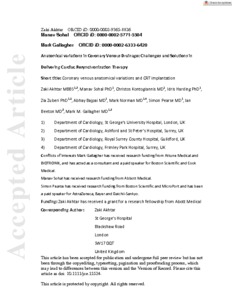Akhtar, Z; Sohal, M; Kontogiannis, C; Harding, I; Zuberi, Z; Bajpai, A; Norman, M; Pearse, S; Beeton, I; Gallagher, MM
(2022)
Anatomical variations in coronary venous drainage: Challenges and solutions in delivering cardiac resynchronization therapy.
J Cardiovasc Electrophysiol, 33 (6).
pp. 1262-1271.
ISSN 1540-8167
https://doi.org/10.1111/jce.15524
SGUL Authors: Gallagher, Mark Michael
![[img]](https://openaccess.sgul.ac.uk/114342/1.hassmallThumbnailVersion/Cardiovasc%20electrophysiol%20-%202022%20-%20Akhtar%20-%20Anatomical%20variations%20in%20Coronary%20Venous%20Drainage%20Challenges%20and%20Solutions%20in.pdf)  Preview |
|
PDF
Accepted Version
Available under License ["licenses_description_publisher" not defined].
Download (1MB)
| Preview
|
Abstract
Aims
To investigate the abnormalities of the coronary venous system in candidates for cardiac resynchronization therapy (CRT) and describe methods for circumventing the resulting difficulties.
Methods
From four implanting institutes, data of all CRT implants between October 2008 and October 2020 were screened for abnormal cardiac venous anatomy, defined as an anatomical variation not conforming to the accepted ‘normal’ anatomy. Patient demographics, procedural detail, and subsequent left ventricle (LV) lead pacing indices were collected.
Results
From a total of 3548 CRT implants, 15 (0.42%) patients (80% male) of 72.2 ± 10.6 years in age with an LV ejection fraction of 34 ± 10.3% were identified to have had an abnormal cardiac venous anatomy over the study period. There were 13 cases of persistent left side superior vena cava (pLSVC), five of which had coronary sinus ostium atresia (CSOA) including two with an “unroofed” coronary sinus (CS); one patient had a unique anomalous origin of the CS and one patient had an isolated CSOA. In total 14 patients (60% repeat attempt) had successful percutaneous implant under general anesthesia (46.7%) via the cephalic vein (59.1%), using the femoral approach (53.3%) for levophase venography and/or pull-through, including one case of endocardial LV implant. Pacing follow-up over 37.64 ± 37.6 months demonstrated LV lead threshold between 0.62 and 2.9 volts (pulsewidth 0.4–1.5 ms) in all cases; five patients died within 2.92 ± 1.6 years of a successful implant.
Conclusion
CRT devices can be implanted percutaneously even in the presence of substantial abnormalities of coronary venous anatomy. Alternative routes of venous access may be required.
| Item Type: |
Article
|
| Additional Information: |
This is the peer reviewed version of the following article: Akhtar, Z, Sohal, M, Kontogiannis, C, et al. Anatomical variations in coronary venous drainage: challenges and solutions in delivering cardiac resynchronization therapy. J Cardiovasc Electrophysiol. 2022; 33: 1262- 1271, which has been published in final form at https://doi.org/10.1111/jce.15524. This article may be used for non-commercial purposes in accordance with Wiley Terms and Conditions for Use of Self-Archived Versions. This article may not be enhanced, enriched or otherwise transformed into a derivative work, without express permission from Wiley or by statutory rights under applicable legislation. Copyright notices must not be removed, obscured or modified. The article must be linked to Wiley’s version of record on Wiley Online Library and any embedding, framing or otherwise making available the article or pages thereof by third parties from platforms, services and websites other than Wiley Online Library must be prohibited. |
| Keywords: |
Anomalous coronary sinus, Cardiac Resynchronisation Therapy, Persistent left superior vena cava, Subclavian Vein, Cardiovascular System & Hematology, 1102 Cardiorespiratory Medicine and Haematology |
| SGUL Research Institute / Research Centre: |
Academic Structure > Molecular and Clinical Sciences Research Institute (MCS) |
| Journal or Publication Title: |
J Cardiovasc Electrophysiol |
| ISSN: |
1540-8167 |
| Language: |
eng |
| Dates: |
| Date | Event |
|---|
| 8 June 2022 | Published | | 13 May 2022 | Published Online | | 3 May 2022 | Accepted |
|
| Publisher License: |
Publisher's own licence |
| PubMed ID: |
35524414 |
 |
Go to PubMed abstract |
| URI: |
https://openaccess.sgul.ac.uk/id/eprint/114342 |
| Publisher's version: |
https://doi.org/10.1111/jce.15524 |
Statistics
Item downloaded times since 10 May 2022.
Actions (login required)
 |
Edit Item |



